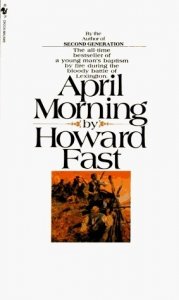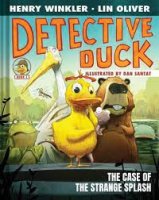' "Lay down your arms, you lousy bastards! Disperse, do you hear me! ...Get off the King's Green!" '
It's Lexington, Massachusetts, April, 1775. Anxious, almost sixteen-year-old Adam Cooper is growing up fast but perhaps too fast for his parents: ' "...I want to go to the meeting, Father. ...I know the committee made a rule about sixteen years before a man enters”--[Father] “Are you a man now, Adam?” (Adam) “I'm tall and strong and only nine months from my sixteenth birthday." ' The colonies are rebelling and so is Adam. The Lexington militia has formed; he wants to be in it. His father finally relents. The British army marches from Boston towards Concord and the Lexington militia is in the way. Upon coming under fire, Adam panics and flees. However, once the shock subsides and he is calmed by an old veteran, Adam is battle tested again. This time he doesn't run. Although little more than twenty four hours passes, it seems like years. Later, at home, as he falls asleep bone tired, he realizes he's "...said farewell to childhood, a world, a secure and sun-warmed existence and past that was over and done with and gone away for all time."
Ernest Hemingway said, "American fiction begins with Huck Finn." For American "war fiction", it has been Stephen Crane's Civil War classic, The Red Badge of Courage, and all authors know it. With April Morning, published in 1961, many believe Crane's supremacy has been successfully challenged. Initially, it was written as serious, adult literature. But because of the young main character, captivating narrative, and less than two hundred pages, it was quickly adopted by middle- and high-school curricula. Once categorized as a teen title, the label sticks. Unfortunately, too many good, serious novels are underestimated as merely YA literature.
All of us book people have title lists and authors we believe have been unfairly forgotten. Howard Fast is one of mine. Of over fifty books published, his Citizen Tom Paine (1943), Freedom Road (1944), The Crossing (1971), and the 1972 Hessian (see review) are worth having in any collection. Blacklisted and jailed during the McCarthy hysteria, the author's Spartacus (1951) was self published, became a bestseller, and later became the Kirk Douglas movie.
There are a number of good Revolutionary War novels out there. Arundel and Rabble in Arms by Roberts are old reliables along with Edmonds's Drums Along The Mohawk. Bristow's Celia Garth still deserves mention. Jeff Shaara's Rise To Rebellion (2001), and sequel The Glorious Cause (2002), and Gingrich & Forstchen's To Try Men's Souls (2009) and Valley Forge (2010) are fine, recent additions. The page turning and prolific historical novelist, Bernard Cornwell, never disappoints--see his Redcoats (1998) and just published The Fort (2010). Educators and librarians are probably familiar with YA titles such as the 1985 Newberry winner My Brother Sam Is Dead by Collier & Collier, Snow's Freelon Starbird (1976) and Finlayson's Silver Bullet (1978). Although difficult to come by other than via the used market, I'm still getting some checkout activity by boys with the Bruce Lancaster YA historical adventures written in the fifties and the 1960s biographical YA novels of Noel B. Gerson (The Swamp Fox).
208 pages 978-0553273229 Ages 12 and up
Recommended by Robert L. Hicks, Librarian, Kansas USA






